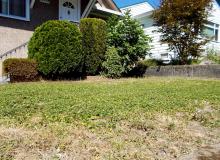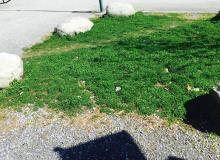
Photo: Micro-clover
With the march of Chafer Beetle across the lower mainland , we are looking for alternatives to turn to. Be aware that the chemicals promoted to kill European Chafer are banned in many cities and districts as they are toxic to bees
Chafer beetle naturally fly towards sunset which has helped their march west from New Westminster, where they were first discovered. They also fly towards street lights on boulevards , which is why you'll see more damage in some areas.
- Damage is seen in the fall to early spring when the grubs are full-grown. Grubs will feed all throughout the winter until they pupate in May.
- Adults may emerge from April to late June. Eggs hatch in mid July , tiny grubs begin feeding on roots of grass. The worst damage from feeding can be seen in February and March.
-
If you reseed damaged areas in April and May your lawn should be able to recover for the summer. Stressed turf in high traffic areas is best replaced with paving stones or alternative ground covers
- The damage these beetles cause can be masked by abundant moisture in spring and fall, but drier weather quickly results in the appearance of brown patches on your grass. More here
Micro clover is a suggested alternative. micro-clover doesn’t need mowing, it mainly goes brown over winter. It can take 2-3 years to establish
Dutch White Clover is also an attractive ground cover and reports are that when intermixed with regular grass, damage is minimal.
Other feedback from members: West Coast Seeds is selling tall fescue (a taller more resistant grass) mixed with micro-clover. Kerrisdale lumber also sells this mix. This mixture is recommended for bare soil, not overseeding.
GROW GREEN: UBC Botanical Garden in partnership with the Metro Vancouver has a great site with tons of information which helps you tailor suggestions towards your specific needs here
The Flower photos of Ajuga reptans and Violets below, were kindly shared by Christine Allen who requests that you don't share them without her permission










